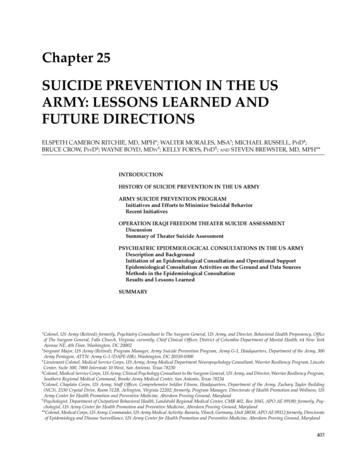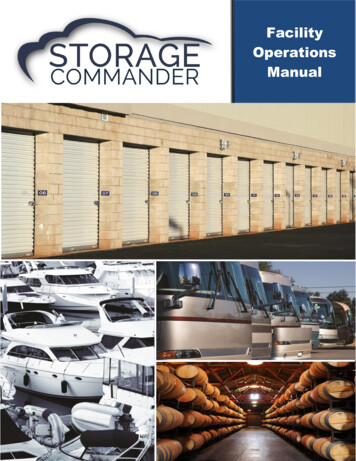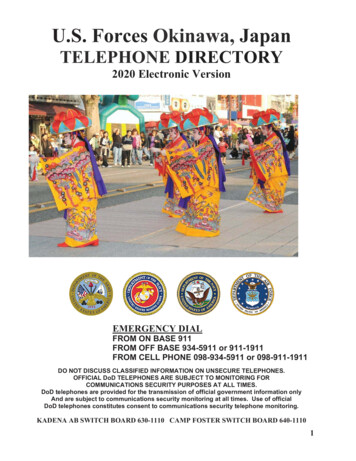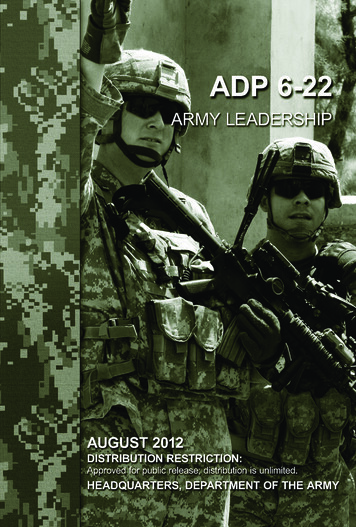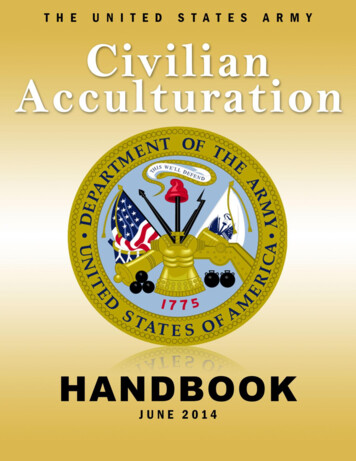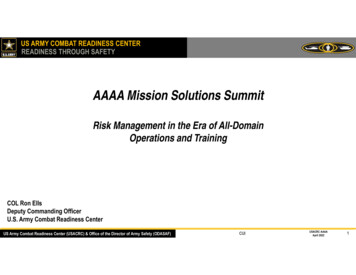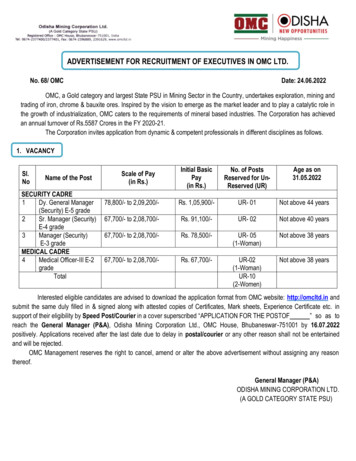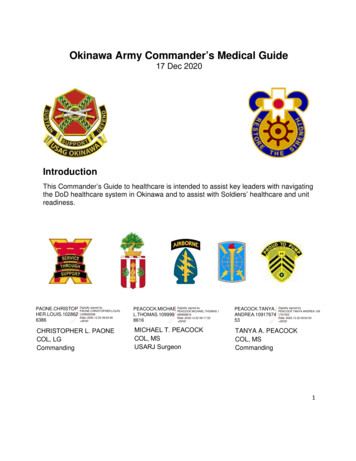
Transcription
Okinawa Army Commander’s Medical Guide17 Dec 2020IntroductionThis Commander’s Guide to healthcare is intended to assist key leaders with navigatingthe DoD healthcare system in Okinawa and to assist with Soldiers’ healthcare and gitally signed byPAONE.CHRISTOPHER.LOUIS.1028626386Date: 2020.12.22 09:20:40 09'00'CHRISTOPHER L. PAONECOL, LGCommandingsigned byPEACOCK.MICHAE DigitallyPEACOCK.MICHAEL.THOMAS.1L.THOMAS.109999 099998616Date: 2020.12.22 09:17:228616 09'00'MICHAEL T. PEACOCKCOL, MSUSARJ SurgeonPEACOCK.TANYA.ANDREA.1091767453Digitally signed byPEACOCK.TANYA.ANDREA.1091767453Date: 2020.12.22 09:03:53 09'00'TANYA A. PEACOCKCOL, MSCommanding1
2
The US Army does not have an Army Medical Treatment Facility (MTF) in Okinawa. WhileOkinawa has Soldiers, Airmen, Sailors and Marines, it is not officially designated a Jointenvironment. The resources, capabilities and dynamics of a Joint environment are differentthan when the services are merely co-located. This directly impacts the Military Health Servicesin the environment. The Soldiers must enroll into Navy Medicine Readiness and TrainingCommand Okinawa (NMRTC) or the Air Force 18th Medical Group Clinic (18th MDG, Kadena AirBase) for their health care needs. The healthcare structure and operations of the NMRTC and18th MDG are specifically aligned with their respective service mission and regulations. Withoutan officially designated Joint environment, their higher commands do not consider the Army’spresence or regulatory requirements when planningCommander’s Note:and funding their required missions. The intent of thisdocument is to reduce the confusion for ArmyCommanders need to becomepersonnel in this complicated medical environment.familiar with the Army RegulationsThe proponent of this document is the MEDDAC-Japanrelated medical readiness, profiles,Commander in cooperation with the NMRTC and 18thseparations, and Medical Boards.MDG Commanders. Questions and recommendationsfor this guide may be directed to the MEDDAC-JapanDCCS.This guide will outline steps for readiness. Soldier Individual Medical Readiness (IMR)is the Soldier’s personal responsibility, and unit Readiness is the Commander’sresponsibility which is the Number 1 Priority for the Army Chief of Staff 1.1Army Chief of Staff Memo 20 Jan 2016. Army Readiness Guidance3
Contents:1)General Medical Care for Army Personnel in Okinawa2)Army Medicine in Japan3)Military Treatment Facilities in Japan4)Healthcare in the Okinawa Community5)Medical Readiness: PHA6)Medical Readiness: Profiles7)Medical Readiness: MEDPROS8)Medical Readiness: Emergency Care and After hour care9)Behavioral Health and Substance Use and Abuse Care10)Substance Use Disorder Clinical Care: 18th MDG Clinic 211)Substance Use Disorder Clinical Care: NMRTC 312)Army Body Composition Program (ABCP)13)EFMP14)Protected Health Information15)Soldier Reassignments and Returning Family Members16)AppendicesA. Key Personnel and Contact informationB. Medical Readiness Definitions/CodesC. Behavioral Health ProfilesD. Blank E-Profile FormE. ASAM Levels of CareF. Behavioral Healthcare options on Kadena and 18th MDGF1. Air Force ADAPT AlgorithmF2. Kadena Family Advocacy ProgramG. Behavioral Healthcare options at U.S. NMRTC Okinawa, Camp Foster23Air Force’s Alcohol and Drug Abuse Treatment and Prevention (ADAPT)Navy’s Substance Abuse Rehabilitation Program (SARP)4
G1. U.S. NMRTC Okinawa Flowchart for Inpatient Mental HealthG2. Navy SARD AlgorithmH. U.S. Army Garrison UnitsI. Glossary of Terms and AcronymsJ. Community Resources for U.S. Army Okinawa5
General Medical Care for Army Personnel in OkinawaOnce registered at the Okinawa TRICARE service center every Active Duty Soldier andfamily member on their orders are considered a TRICARE Prime enrollee. Soldiers andActive Duty Family Members (ADFMs) enrolled in TRICAREPrime are assigned to a primary care manager (PCM) inorder to maximize continuity of care with one provider orone medical team often referred to as a “Medical Home”. Theirenrollment is linked to the clinic’s appointment lines, TRICARE Online (TOL) andSecure Messaging 4 to maintain the continuity between the patient and their medicalteam. The patient Portal is one example of TRICARE’s continuous efforts to improvehealthcare services and knowledge.Commander’s Note:More information can be obtained athttps://www.tricareonline.com.The Blue Button is an added capability for the patient.Individuals that receive medical care atThe Patient/Soldier can use this feature to follow-up onany DoD MTF can use the “Bluetheir results as well as show evidence to theButton” to see lab results, radiologycommander of their compliance with medical readinessresults, Immunizations, andas long as they are not coerced to reveal protectedmedications. Prescriptions written atan MTF can be refilled at TOL whenhealth information.active refills are available for thatprescription number.Active Duty Soldiers, Sailors, Marines, and Airmen are entitled to the same medicalbenefits regardless of the MTF utilized. Additionally, when a Soldier’s unit has organicmedical assets, Active Duty Soldiers may seek medical care from their unit medicalteam per the unit’s SOP. Receiving medical care at the ADSM’s unit doesn’t alter theirstatus with their PCM, this option remains open to all Soldiers.Patient Portal Secure Messaging allows patients to email their PCM care team. Patients have to register at theirlocal MTF or update when they arrive in Okinawa.46
Access to the MTFs is prioritized to ADSMs 5. Generally ADFMs receive the same orvery similar access as the Active Duty Soldier. Other eligible beneficiaries may beconsidered “Space Available,” meaning medical care is available as capacity oravailability allows at the MTF.Commander’s Note:The concept of “Sick-Call” changed drastically when the “Medical Home” was adopted. Thetraditional Sick-Call has a limited role in which the Army has generally relegated to specific units,locations, and conditions. All Medical Homes reserve same day appointments to address acutemedical issues. Soldiers can call the appointment line to request a same day appointment. If yourSoldier is unable to reserve a needed same day appointment, they should leave a telephonemessage with their PCM explaining what their needs are, such as a profile, medication refill etc.Some needs can be handled over the phone. If the Soldier is unsure about their symptoms, theycan also ask for advice about using the ER.Army Medicine in JapanUnited States Army Medical Activity-Japan (MEDDAC-J) is the only Army MTF inJapan, it is located at Camp Zama on the main island. The BG Crawford F. Sams ArmyHealth Clinic is run by MEDDAC-J and provides care to the local Camp Zamapopulation.MEDDAC-J also tracks medical readiness for all of US Army Japan. In order to assistwith Army related administrative functions as well as readiness, MEDDAC-J has severalemployees located in Okinawa. MEDDAC-J staff will conduct medical and behavioralhealth in/out-processing and Newcomer Briefings. The locations and roles are subject tochange based on the needs of the local Army population and Army requirements.Two Nurse Case Managers (NCM) are employed by MEDDAC-J to assist with complexmedical and at-risk behavioral health cases to include scheduling appointments,tracking referrals, overseeing BH profiles, initiating medical boards, curtailments,compassionate reassignments and Exceptional Family Member Program (EFMP)enrollments and updates.NCMs also assist with patient movement that requires evacuation to medical facilitiesoff the island. Transportation arrangements include military air and commercial airlines.5HA POLICY: 11-005; TRICARE Policy for Access to Care, Feb 23, 20117
NCMs maintain communication with Command teams to ensure command and controloversight for Soldiers while in treatment.A Social Services Assistant (SSA) is employed to assist commands and patients forreferrals, assessments and treatment related to substance use disorders (SUD),Command Mental Health evaluations (CDMHE), and Tele Behavioral Health (TBH).This individual will assist patients and commands with the process of obtainingevaluations, including the required paperwork, and following the progress of the Soldierduring their evaluation and care. The SSA will assist with educating Soldiers andCommands on accessing behavioral health resources on Okinawa. The SSA serves asthe primary POC for all SUDCC referrals to NMRTC SARD or 18TH MDG ADAPT.1-1 ADA medical personnel have assisted with medical related administrative roles suchas profiles and medical readiness documentation. The battalion PA transcribes medicaldocumentation into Army profiles. The availability of the 1-1 ADA medical team toassist is subject to mission requirements and may change unexpectedly. If they are notreadily available to assist, Soldiers are encouraged to contact the Army NCM at ToriiStation for further assistance.1-1 SFG medical capabilities include a Battalion Surgeon, Battalion PA, BehavioralHealth Provider (Psychologist), SUDCC/BH provider (LCSW), MFLC, and a PhysicalTherapist (PT). Their mission is limited to the Special Forces unit. Services providedinclude primary care (sick call) and Soldier Readiness evaluations to include militaryschool physicals, PHA’s and PDHRA’s. The 1-1 SFG Soldiers can use their medicalteam for appointments or they can exercise the option to schedule an appointment withtheir PCM or Mental Health Clinic at Camp Foster by calling the appointment line.For all other Army units on Okinawa, their assigned PCM will facilitate and coordinatethe proper care for the Soldier and ADFM. If there are any concerns with access tocare, ensure the Soldier or ADFM contacts the NCM or one of the other Army medicalteam members for assistance. These Army medical team members can assist withunexpected changes and elevate medical concerns to higher levels quickly. SeeAppendix A for names, locations and contact information of the personnel describedabove.Army Soldiers and their family members who are empaneled under 18th MDG are ableto access Tele-Behavioral Health (TBH) for psychiatry appointments provided by TriplerArmy Medical Center (TAMC) at Kadena Mental Health Clinic. The patient would needto contact 18th MDG appointment line at 630-4817 Option 1, 2, 1 to be screened first orthe patient could walk-in to the Mental Health Clinic, Bldg. 90 from 0730-1530 MondayFriday. The Air Force MH clinic will assist the patient with scheduling a TBHappointment.8
Army Soldiers and their family members who are empaneled under NMRTC are able toaccess TBH for therapy and psychiatry appointments at Torii Station, Bldg. 216, RM232. The patient would need to contact the MEDDAC-J NCM at 652-5437 to schedulean appointment with TAMC TBH. It is anticipated that NMRTC Okinawa will also haveTelehealth capabilities with TAMC TBH in the near future.Military Treatment Facilities18th Medical Group, Kadena Air Base (18th MDG Clinic) is theMTF designated for the 1-1 Air Defense Artillery (1-1 ADA)Soldiers and Family Members. The Active Duty Soldiers of the1-1 ADA are enrolled to the ADA clinic located on the first floorof the 18th MDG clinic and staffed by the ADA battalionphysician assistant (PA). Soldiers assigned to the Army PublicHealth Activity and the 680th Contracting on Kadena Air Baseare also assigned to this clinic.Additional assistance is provided by the18th MDG staff as needed. ADFMs areenrolled to 18th MDG primary care teams.U.S. Navy Medicine Readiness and Training Command Okinawa(NMRTC), on Camp Foster is designated for Soldiers and Familymembers of all other Army Units 6 primarily operating out of ToriiStation Army Garrison.Healthcare in the Okinawa CommunityThe host nation TRICARE network that augments military medicine capabilities havelimited options compared to the TRICARE network in the United States. The Japanesemedical facilities may require a cash payment before and/or after medical care isprovided. The TRICARE International SOS (Pacific area) will make these initialpayments for TRICARE beneficiaries with a referral and authorization. There may bemedical facilities that don’t have contracts (agreements) with TRICARE. Therefore,individuals seeking medical care on their own should be prepared to pay the equivalentof several hundred dollars in Yen. Eligible beneficiaries should contact the TRICAREOverseas Program contractor International SOS (Pacific) to coordinate claims paymentsand reimbursements. More information can be found at http://www.tricare-overseas.comMedical Readiness: PHA10th Area Support Group; 1st Battalion, 1st Special Forces Group (1-1 SFG); 78th Signal Battalion; 333rd Signal;USA NEC-O; 53rd Signal; 835th Transportation; 247th Military Police; CID; 500th Military Intelligence; Dentac69
Medical Readiness 7 is the highest priority for the Army. The Periodic HealthAssessment (PHA) is the tool used by the DoD to document and track IMR 8. The PHAis an annual requirement. A Soldier’s PHA is considered overdue when the date of thelast PHA is more than 15 months. As part of the Medical Readiness Transformation 9,the Army, Navy and Air Force now have the same PHA requirements. While the PHArequirements are the same, the service’s use different programs that lackinteroperability. Efforts are underway so that all three services will have the capability ofcompleting PHAs for any Active Duty member. The status of the PHA is available tocommanders in the MEDPROS’s Commanders’ Portal.The PHA involves three sections (phases):1) Soldier’s Self-Assessment questionnaire which can be accessed through AKO2) Record Reviewer Section can be completed by a nurse, medic or health careprovider.3) Healthcare Provider Section is completed, duty limitations annotated, andprofiles are updated as needed.Medical Readiness: Army ProfilesArmy Profiles 10 are completed electronically on which generates a DA Form 3349. Thiselectronic profile (E-profile) consolidates all of a Soldier’s profile conditions on one form.The E-profile is reviewed in the Commander’s Portal11 (MEDPROS) and signed toacknowledge and concur. The Commander’s portal allows the commander to messagethe healthcare provider about a profile in order to clarify information such as limitationsor deployability. More information for the Commander can be found in the CommanderPortal User Guide 12. Individual Sick Slips (DD Form 689) are used occasionally and areonly valid up to 7 days. When capability allows, the E-profile is the preferreddocumentation method for the Army profiles.E-profile is an online program specific to the Army. Active Duty and Civilian providersfrom Air Force and Navy are authorized to use the system, but use of the system byother services is voluntary and sporadic. As long as the provider documents thediagnosis, limitations and duration of the limitations in the Electronic Medical Record, aprofile can be generated for the Soldier in E-profile by a surrogate Army provider.See Appendix B for definitions related to Medical Readiness CategoriesDoDI 6200.06 Periodic Health Assessment Program9FRAGO 5 to HQDA EXORD 037-16 Personnel and Medical Readiness Transformation Training10Currently Army Retention Standards and Profiling information are found in AR 40-501.11 All users must complete the JKO Course Number, DHA-US062: Personnel Readiness Transformation, and selfregister at n?ReturnUrl %2fMCP%2fHome12A copy of the Command Portal User Guide PDF is located on https://www.milsuite.mil/book/docs/DOC-3782267810
Assistance is available by the Army NCMs or a representative from the 1-1 ADAmedical team. If a profile is transcribed for another medical provider, the commandermay still use the commander’s portal, but the message will not reach the treatingmedical provider. Extra steps are required to reach the treating physician. NCMs canassist with getting commanders’ questions answered.Profiles are supposed to be written for a duration that includes the recovery period forthe profiling condition. The recent changes in the profiling system may not be fullydisseminated so commanders are encouraged to exercise caution and verify whenconcerns for injury are identified for their Soldier. The new profiling regulations directproviders to use laymen terms in communication to reduce medical jargon that may notbe widely understood and to protect privacy as much as possible. Finally, a recordAPFT can be conducted on a temporary profile asCommander’s Note:long as it doesn’t violate the limitations in theprofile. Commanders are encouraged to verifyCommanders should be familiar withlimitations and intended APFT events astheir Soldiers’ medical conditions inproviders from other services may not be awareorder to accurately determine if theyof the Army’s regulations when they are initiallyare deployable. The Commander’sproviding instructions for limitations.See Appendix C for more information for medicalproviders regarding Army profiles includinginformation specific to 18th MDG Clinic Provider.portal is vital to accurate recordkeeping.See Appendix D for an example of the blank DA 3349 Form used by E-profile. Thedemographic data populates automatically. The example offers non-Army providers anexample of the content they may need to address in their medical documentation tocommunicate effectively with Army leaders.Medical Readiness: MEDPROSThe commander’s MEDPROS determination of deployable personnel will automaticallyfeed into the commander’s unit status report (USR) in the Defense Readiness ReportingSystem-Army. The Medical Readiness Classes (MRCs) and Deployment Limiting (DL)codes are defined below.1) MRC 1: Fully medically ready and deployable. Current Profiles are 7 days inlength.2) MRC 2: Soldiers are partially medically ready and deployable. Includes Soldierswith profiles 8-14 days in length. Includes Soldiers whose vision or hearing isclassified as class 4.11
3) MRC 3: Soldiers who are not medically ready and considered non-deployable.CodeDL1DL 2DL 3DL 4Description of Deployment Limiting CodeTemporary profile greater than 14 daysDental Readiness Class 3PregnancyPermanent profile indicating MOS Administrative Retention Review (MAR2)neededDL 5Permanent profile indicating Medical Evaluation Board (MEB) neededDL 6Permanent profile indicating non-duty-related action is neededDL 7Permanent profiles with a deployment / assignment restriction code (F, V orX)Commanders will determine in the Commander’s Portal whether a Soldier with DL code 1or 2 is deployable after reviewing the Soldier’s physical profile.4) MRC 4: This class of Soldiers is not medically ready and will default to nondeployable unless a commander determines in the Commander’s Portal that aSoldier is deployable. Commanders are required to resolve any medicaldeficiencies before a Soldier’s deployment.This category includes Soldiers that may simplyneed to update their PHA.Emergency Care and Afterhours CareThe NMRTC operates a 24 hour emergency room at Camp Foster. The Army Garrisonat Torii Station maintains an MOU with NMRTC to provide emergency medical transportservices to NMRTCa. If a patient is feeling suicidal, homicidal, or is in crisis, they can call 911 or098-934-5911 from cell or report directly to NMRTC Emergency Department.b. Crisis hotline is available 24/7, 1-800-273-TALK (8255)Behavioral Health and Substance Use Disorder Clinical CareBehavioral Health 13 programs and clinics are generally run in a similar fashion across allthree DoD services. Substance Use Disorders is a mental health diagnosis, buttreatment is often conducted in specialized programs. The Army, Air Force and Navyhave separate programs for substance use disorders which include treatment,education and preventative programming. The clinical decision making process andtreatment options for substance use disorders are the same regardless of service andare promulgated by the American Society of Addictions Medicine (ASAM), 14 theThe Army replaced the label “Mental Health” with “Behavioral Health.” For the purposes of this document, theterms are synonymous. The use of “Mental Health” in this document is to keep the wording consistent with theterminology of the Air Force and Navy when it applies.14DoDI 1010.04; See Appendix E1312
Diagnostic and Statistical Manual, 5th edition (DSM 5), and Department ofDefense/Veteran Affairs Clinical Practice Guideline for Substance Use Disorders. 15The Army Substance Abuse Program (ASAP) has undergone several transformations inthe last 10 years. In October 2016 the Secretary of the Army separated thecommander’s administrative role, known as ASAP, from the medical role identified asSubstance Use Disorder Clinical Care (SUDCC). 16 While the terms are frequently usedinterchangeably, there are distinct differences in their purpose and function. ASAP is acommander’s program that emphasizes readiness andpersonal responsibility. The standards that delineate punitiveCommander’s Note:and corrective actions in regards to substance use areThe Army’s Substance Use Disordercontained within the ASAP policies. The decision regardingseparation or retention for substance abuse rests with thePolicy has changed several times inSoldier’s chain of command. The commander’s role inthe last decade. The Army’s SUDCCsubstance abuse prevention, drug and alcohol testing, earlySSA on Torii Station can assist withidentification of problems, rehabilitation, and administrative orcoordinating consultation with Armyjudicial actions is essential to the overall success of themedical providers that can helpprogram and maintaining good order and discipline within thecommander’s understand the Armyunit.Regulations. They can review thecare given by the Air Force or Navyand make recommendations basedon the Army Regulations.The Army’s Installation Management Command (IMCOM),the local Army Garrison, retains responsibility and policyoversight of ASAP drug deterrence and testing programs,prevention functions (i.e. Alcohol and Drug Abuse PreventionTraining or ADAPT), and the ASAP training curriculum. 17MEDCOM was assigned the responsibility of evaluation and treatment for substanceuse disorders.The Army MEDCOM policies regarding SUD have evolved during the transformation ofthe program. The diagnosis is treated as a Behavioral Health disorder. Treatment forthe disorder and treatment failures are determined by the Behavioral Health provider,not by the completion of a defined program. The determination of successful treatment,treatment failures, and non-compliance with treatment are clinical assessments thatdetermine the options for the commander. Commanders should refer to ArmyRegulations to determine eligibility for retention or separation. In such cases whereArmy Regulations may not be clearly applied, the option for continued treatment may beconsidered as long as the Soldier is able to return to a deployable status within s/mh/sud/AR 600-85 28 November 2016, Chapter 1 (1-7), page 117FRAGO 1 OPORD 16-33, Page 2151613
The following two sections describe the Air Force and the Navy Substance UseDisorder (SUD) evaluation and treatment programs. There are subtle differencesbetween the three services. Please reference the section that corresponds to thelocation the Soldier will receive their care. In accordance with the Secretary of theArmy’s Army Substance Abuse Program Report, MEDCOM has final authority regardingdecisions that impact a Soldier’s health and rehabilitation when there are conflictingopinions between the Commander and the healthcare provider on the best course oftreatment for Soldiers (IAW DA EXORD 191-16), SUDCC is not a part of theCommander’s ASAP, but is clinical treatment with a Behavioral Health provider. 18SUD Programs and staff don’t provide intervention services or assessments for patientswho are inebriated or otherwise under the influence of a substance. SUD is notconsidered a medical emergency, it is a medically related behavioral healthdiagnosis/condition treated in an outpatient or inpatient setting, not the EmergencyDepartment. Individuals who are under the influence (drunk, high) should have amedical evaluation when there are concerns for health and safety. Chronic heavydrinkers and substance users are at risk for withdrawal symptoms such as vomiting andseizures. When somebody is under the influence of alcohol or other substances,altered mental status are common. However, if head trauma is suspected, a medicalassessment should be performed. Likewise, a patient suspected of poly-substance useor ingestion (alcohol drugs or medications) which may occur with an attempted suicideor other high risk behaviors is also a situation that warrants further medical evaluation.If the risk assessment is low for the individual, it is appropriate to monitor the individualin a safe non-clinical environment.Substance Use Disorder Clinical Care: 18th MDG ClinicThe Air Force’s Alcohol and Drug Abuse Prevention and Treatment (ADAPT) and DrugDemand Reduction (DDR) programs are the equivalent to the Army’s SUDCC andASAP programs 19. The Air Force directs Airmen to seek help early through selfidentification which is consistent with Army policies. An assessment with the 18th MDGADAPT will determine the appropriate clinical course of action (e.g. nodiagnosis/education only; or diagnosis/ASAM level of treatment). All Soldiers beingreferred to ADAPT must meet with the Army Social Services Assistant prior to theirassessment with ADAPT. This is to ensure any governing Army and SUDCC policiesare thoroughly explained to the Soldier.Individuals who have a substance related misconduct in the Air Force are commandreferred for an assessment within seven days of the incident, or next duty-day fordriving under the influence specifically. A supervisor must be present to the1819MEDCOM OPORD 16-33 Fragmentary Order 3Air Force Instruction 44-121, published 8 July 201414
appointment with the member to complete a supervisor interview, and the time/date ofthe appointment will be coordinated through the First Sergeant who has theresponsibility of notifying the member, supervisor and the commander.The self-identified or medical referred ADSM or dependent that warrants treatment areheld to the same standards as others entering substance use disorder treatment. Incases of self-referral or medical referral, if the individual is not diagnosed with a SUD,then the ADSM’s chain of command will not be notified. In cases where a self-referralor medical-referral meets criteria for a SUD (Level I-III), the command team is notified toarrange for a comprehensive treatment planning. The notification is non-punitive, but isnecessary to arrange for appropriate treatment.Within 14 days of the initial assessment, a meeting will be held with the TreatmentTeam which includes the Commander and/or First Sergeant and supervisor. TheSoldier’s leadership is involved at program entry, termination, and any time there aresignificant treatment transitions or difficulties with the patient (e.g. relapse, poorengagement with treatment, 2 no-shows, graduation into aftercare). ADAPT staff mustbrief the unit leadership quarterly, at a minimum. The treatment is not consideredcompleted until the patient has completed treatment and continuing care (aftercare).Substance Use Disorder Clinical Care: NMRTC OkinawaThe Navy’s unified Navy Alcohol and Drug Abuse Prevention (NADAP) wasimplemented in 2009. The Navy’s treatment program is the Substance AbuseRehabilitation Program (SARP). 20 The program utilizes the Alcohol and DrugManagement Information and Tracking System (ADMITS) to maintain a computerdatabase to document alcohol prevention education, command/self-referrals, alcoholrelated incidents, screenings and treatment.Command referrals, self-referrals, and medical referrals will have a screeningconducted by SARP. Prior to a screening by SARP, the command must complete aDAPA screening package and OPNAV 5350/7 created from the ADMITS Web site. Dueto this requirement, Soldiers’ Commands must be notified and eliminates theiranonymity. This notification is non-punitive and required for collaborative informationfrom the Soldier’s leadership. The SARP must receive the following information: 211) A statement or reason for referral (for non-incident) or Drug and Alcohol AbuseReport (DAAR, for an alcohol-related incident).2) ADSMs health and service records/Clinical Package2021BUMED Instruction 5353.4B, 7/6/2015OPNAV Instruction 5350.4D (N135), 6/4/200915
3) DAPA screening packageAt the screening, the medical officer or LicensedIndependent Provider (LIP) at SARP will determinethe presence and potential severity of a substanceuse disorder, and recommend a correspondinglevel of intervention or treatment. Upon completionof the screening, the command is provided awritten summary that will contain treatmentrecommendations and a statement of themember’s amenability to treatment. The summarydoes not contain recommendations for discipline,retention, or separation from service.Commander’s Note:Clinical decision making process isenhanced by historical information toinclude a supervisor’s input. Thesupervisor’s description of the Soldierand past performance is invaluable tounderstanding a baseline, predictingoutcomes, and matching the Soldierto the appropriate treatmentoutcome. Completing thisinformation prior to the Soldier’s visitmakes the best use of a clinician’stime, especially when their servicesare in high demand.At the completion of early intervention ortreatment, SARP 22 will provide an End ofTreatment Memorandum to the Army SUDCC Social Services Assistant, which willinclude a diagnosis, prognosis, aftercare plan, and Fitness for Duty determination. TheSocial Services Assistant will notify the Soldier’s Commanding Officer and provide acopy of the Treatment Memorandum.In the Navy’s
Okinawa Army Commander's Medical Guide . 17 Dec 2020 . Introduction. This Commander's Guide to healthcare is intended to assist key leaders with navigating the DoD healthcare system in Okinawa and to assist with Soldiers' healthcare and unit readiness. TANYA A. PEACOCK COL, MS Commanding . MICHAEL T. PEACOCK COL, MS USARJ Surgeon .


